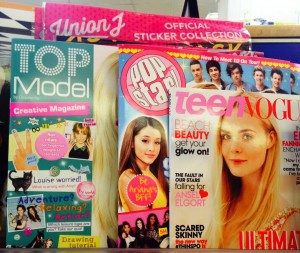 Last month, like Sugar and More before it, Bliss magazine published its last issue. I remember reading all three as a teen girl growing up in 1990s Britain. Girl’s magazines were one of those things that were incredibly important when I was growing up; I just didn’t realise it at the time.
Last month, like Sugar and More before it, Bliss magazine published its last issue. I remember reading all three as a teen girl growing up in 1990s Britain. Girl’s magazines were one of those things that were incredibly important when I was growing up; I just didn’t realise it at the time.
As Daisy Buchanon, a former writer for Bliss explains, magazines like Bliss were places “readers could go when they felt they couldn’t talk to their parents, and their friends might not necessarily have the right answers”.
But did teen girl magazines really have the right answer?
I was in equal measure comforted and dismayed by the magazines I read. Comforted because, yes, they answered the questions I was too shy to ask anywhere else, but I also read them with a not insignificant level of anxiety. Even if teen girl magazines are genuinely and earnestly trying to act like a sort of paper and ink big sister, they can never truly capture the reality of being a teen. I never read a teen magazine that talked about hanging around outside supermarkets in the evening, or how to deal with being the shy one in your gang of wonderful extroverted friends. Likewise, when I couldn’t relate to the issues they talked about, I began to worry that maybe there was something wrong with me. That I was somehow left out or weird – two feelings that teenagers in particular find distressing. Still, I remember those magazines as being in their own way caring. Like a big sister (although without the arguments and fighting) who wanted to give girls the tools they needed to navigate the world themselves.
Paper magazines seem to be dying out. Sugar, More, and now Bliss have gone, although Sugar still exists online at least.
I went to take a look at the shelves for teen girls and was quite shocked to see that apart from comics aimed at much younger girls, most of what was aimed at teen girls were One Direction or Olly Murs special fan magazines. The only magazine I could find that matched the magazines of my teenage years was Seventeen, and that was an American import.
But flicking through that, it seems that not much has changed in girls’ magazines – at least not from my memories. In fact, thanks to the revival of 90s fashion, all that has really changed is the name of the latest teen idol and, of course, the inclusion of social media. Nearly every page encouraged readers to get on Twitter, Facebook, Instagram and Pinterest.
Daisy Buchanon was concerned that without magazines, teen girls would turn to the internet for advice, inspiration and consolation. Of course the Internet is full of damaging and dangerous things, from porn to the Mail Online’s Sidebar of Shame.
But there are also some amazing things out there. Peer educators such as Laci Green on YouTube, or the incredible Rookie Mag, which has taught me, a 29 year old woman, more about feminism, LGBT issues, self-respect and how to apply liquid eyeliner than anywhere else. I wish I’d had access to resources like that – ones that presented all kinds of different points of views and new ideas. And video tutorials about how to create an easy beehive without backcombing my hair to oblivion.
There are a lot of toxic things on the Internet but also a lot of positive things. It’s basically a reflection of the Real World, after all. There are safe spaces out there – we just need to guide teen girls to them.
-Sarah Jackson
Junior Girl
Girl Museum Inc.
Tags: Sarah Jackson, magazines, teen magazines, Daisy Buchanon, journalism, the Internet, Rookie Mag
